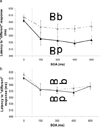Conceptual penetration of visual processing
- PMID: 20483847
- PMCID: PMC4152984
- DOI: 10.1177/0956797610366099
Conceptual penetration of visual processing
Abstract
In traditional hierarchical models of information processing, visual representations feed into conceptual systems, but conceptual categories do not exert an influence on visual processing. We provide evidence, across four experiments, that conceptual information can in fact penetrate early visual processing, rather than merely biasing the output of perceptual systems. Participants performed physical-identity judgments on visually equidistant pairs of letter stimuli that were either in the same conceptual category (Bb) or in different categories (Bp). In the case of nonidentical letters, response times were longer when the stimuli were from the same conceptual category, but only when the letters were presented sequentially. The differences in effect size between simultaneous and sequential trials rules out a decision-level account. An additional experiment using animal silhouettes replicated the major effects found with letters. Thus, performance on an explicitly visual task was influenced by conceptual categories. This effect depended on processing time, immediately preceding experience, and stimulus typicality, which suggests that it was produced by the direct influence of category knowledge on perception, rather than by a postperceptual decision bias.
Conflict of interest statement
Declaration of Conflicting Interests
The authors declared that they had no conflicts of interests with respect to their authorship and/or the publication of this article.
Figures






Similar articles
-
Influence of category identity on letter matching: conceptual penetration of visual processing or response competition?Atten Percept Psychophys. 2012 May;74(4):716-29. doi: 10.3758/s13414-011-0264-x. Atten Percept Psychophys. 2012. PMID: 22231606
-
The effects of concurrent task interference on category learning: evidence for multiple category learning systems.Psychon Bull Rev. 2001 Mar;8(1):168-76. doi: 10.3758/bf03196154. Psychon Bull Rev. 2001. PMID: 11340863
-
Effects of perceptual redundancy, conceptual redundancy and self-relatedness on categorical responses.Q J Exp Psychol (Hove). 2024 Nov;77(11):2165-2179. doi: 10.1177/17470218241237729. Epub 2024 Mar 28. Q J Exp Psychol (Hove). 2024. PMID: 38389154 Free PMC article.
-
A further test of sequential-sampling models that account for payoff effects on response bias in perceptual decision tasks.Percept Psychophys. 2008 Feb;70(2):229-56. doi: 10.3758/pp.70.2.229. Percept Psychophys. 2008. PMID: 18372746
-
Knowledge is power: how conceptual knowledge transforms visual cognition.Psychon Bull Rev. 2014 Aug;21(4):843-60. doi: 10.3758/s13423-013-0564-3. Psychon Bull Rev. 2014. PMID: 24402731 Free PMC article. Review.
Cited by
-
Linguistically modulated perception and cognition: the label-feedback hypothesis.Front Psychol. 2012 Mar 8;3:54. doi: 10.3389/fpsyg.2012.00054. eCollection 2012. Front Psychol. 2012. PMID: 22408629 Free PMC article.
-
Sizing Up Objects: The Effect of Diminutive Forms on Positive Mood, Value, and Size Judgments.Front Psychol. 2016 Sep 23;7:1452. doi: 10.3389/fpsyg.2016.01452. eCollection 2016. Front Psychol. 2016. PMID: 27721802 Free PMC article.
-
Categorical biases in perceiving spatial relations.PLoS One. 2014 May 28;9(5):e98604. doi: 10.1371/journal.pone.0098604. eCollection 2014. PLoS One. 2014. PMID: 24870560 Free PMC article.
-
Instructed illiteracy reveals expertise-effects on unconscious processing.Front Psychol. 2015 Mar 9;6:239. doi: 10.3389/fpsyg.2015.00239. eCollection 2015. Front Psychol. 2015. PMID: 25806011 Free PMC article.
-
The letter height superiority illusion.Psychon Bull Rev. 2016 Feb;23(1):291-8. doi: 10.3758/s13423-014-0753-8. Psychon Bull Rev. 2016. PMID: 26370216
References
-
- Cohen A, Nosofsky R. An exemplar-retrieval model of speeded same-different judgments. Journal of Experimental Psychology: Human Perception and Performance. 2000;26:1549–1569. - PubMed
-
- Delorme A, Rousselet G, Mace M, Fabre-Thorpe M. Interaction of top-down and bottom-up processing in the fast visual analysis of natural scenes. Cognitive Brain Research. 2004;19:103–113. - PubMed
-
- Foxe J, Simpson G. Flow of activation from V1 to frontal cortex in humans: A framework for defining "early" visual processing. Experimental Brain Research. 2002;142:139–150. - PubMed
-
- Gilbert A, Regier T, Kay P, Ivry R. Support for lateralization of the Whorfian effect beyond the realm of color discrimination. Brain and Language. 2008;105:91–98. - PubMed
Publication types
MeSH terms
Grants and funding
LinkOut - more resources
Full Text Sources

